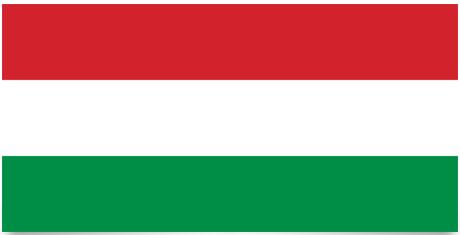Hungary Flag and Meaning
Flag of Hungary

Hungary Flag Meaning
The Hungarian flag was adopted on October 1, 1957 with the proportions 1: 2. Hungary’s trade flag does not look quite the same, it has the proportions 2: 3. The flag, like many other national flags, is a tricolor. This is in the colors red, white and green. The colors come from Hungary’s coat of arms which is a split shield with split patterns on both sides of the split. The red color in the flag symbolizes power. The white color in the flag symbolizes fidelity. The green color in the flag symbolizes hope.
The first Hungarian flag was the Apardian flag, which was added shortly after the 11th century. The 1000s was when Hungary was established as a state in connection with Stefan the First being crowned king.
Hungary Overview
| Population | 10 million |
| Currency | Forint |
| Area | 93.030 km² |
| Capital city | Budapest |
| Population density | 107.4 residents/km² |
| HDI location | 36 |
Hungary is a plain land surrounded by a semi-circle of the Carpathian Mountains. The highest point is 1000 m above sea level. The mountain areas are rich in manganese, bauxite and coal. Between the Danube River and its Tisza tributary there is a very fertile plain, which is the agricultural center of the country. The steppes east of Tisza are predominantly used for cattle farming. Oil and natural gas are found in the Szegia and Zala valleys. 41% of the population is exposed to the right content of sulfur oxides and nitrogen oxides in the air. Emissions of the former are higher than in many countries in Eastern Europe.
A fascist state where right-wing groups freely commit murder and where freedom of assembly and expression is virtually non-existent. Member of EU and NATO. Collaborates with Denmark on concentration camps for refugees.
The people: Magyar (92%), Gypsies (3%), Germans (1%), Slovakians (1%), Jews (1%), slaves (1%), others (1%).
Religion: Catholics (67.8%), Protestants (25.1%), atheists or non-religious (4.8%).
Languages: Hungarian (officially, 98% of the population). In addition, German, Romani and Slovak.
Political parties: Hungary’s Socialist Party (MSZP, the former Communist Party). Hungary Democratic Forum. The Alliance of Free Democrats. The Party of Small Self-Employed. Federation of Young Democrats. The Popular Christian Democratic Party. Hungary Social Democratic Party. Agrarpartiet. Hungary Socialist Workers’ Party.
Social organizations: Hungary’s Central Scientific Council (4.5 million members). Hungary’s Feminist Network.
Official name: Magyar Kösztarsasag (then Republic of Hungary)
Administrative subdivision: 19 counties and the capital
Capital: Budapest, 1,721,566 residents (2008)
Other important cities: Debrecen, 209,600 residents; Miskolc, 181,900 residents; Szeged 170,600 residents (2000)
Government: János Áder, President since May 2012, re-elected in 2017. Viktor Orbán, Prime Minister since May 2010, re-elected in 2014 and 18. One-chamber parliamentary system with a National Assembly of 199 MPs elected for a four-year term.
National Day: March 15 (Independence, 1848). October 23 (Declaration of the Republic, 1989)
Armed Forces: 64,300 (1996)
Paramilitary forces: Border Guard (15,900), Civil Defense (2,000), Internal Security Forces (2,500).













































